This is what you have to eat to compete in the Tour de France
Three weeks, 21 stages, 3,351km, 176 cyclists and a combined burn of 25 million calories — so what exactly goes into fuelling the riders of the Tour de France?
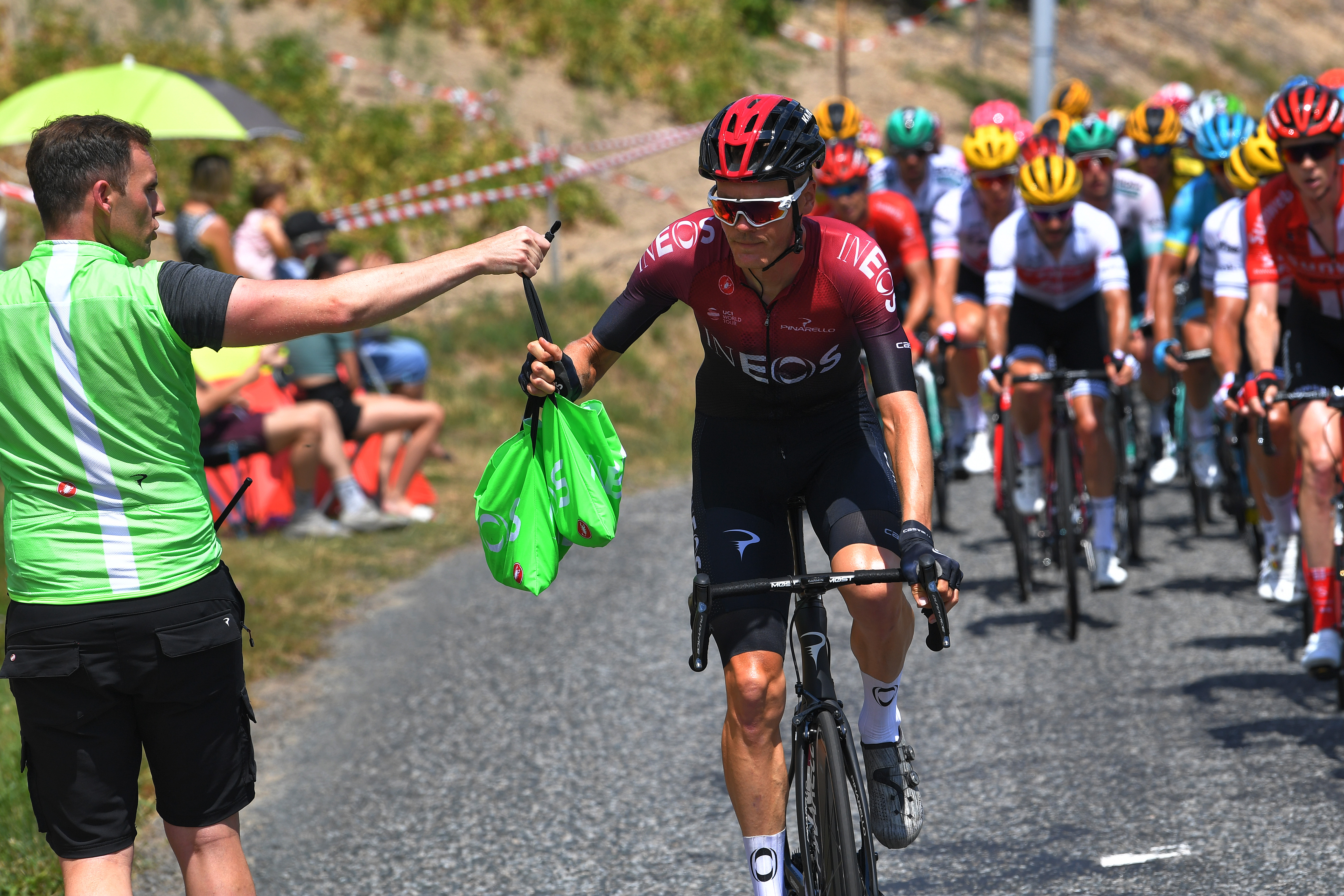
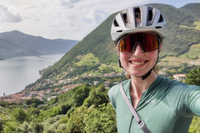
Described as one of the most gruelling endurance events on earth, the Tour de France is as nutritionally challenging as it is physical. With riders spending up to six hours a day on the bike with minimal time for recovery and just two rest days over the entire event, feeding the world’s greatest riders during a Grand Tour is no mean feat.
“To fuel the journey riders need to consume an average of 5,000-plus calories per stage. Maintaining such a huge energy intake is challenging,” says Corinne Mäder, senior sports nutritionist at PowerBar.
But it’s not just the calories. “Suppression of appetite and meal fatigue due to eating the same food every day for weeks must also be managed,” adds Mäder.
“Gastro-intestinal problems can also occur, especially during the latter part of the race, and sports nutrition products and food must therefore be selected carefully and tailored to the individual rider.”
Couple this with eating on the bike, ensuring adequate hydration and recovery, moving between hotels and the sheer length of the Tour de France and you’ve got a mammoth task on your hands. So how exactly is it done?
Diet of a tour rider
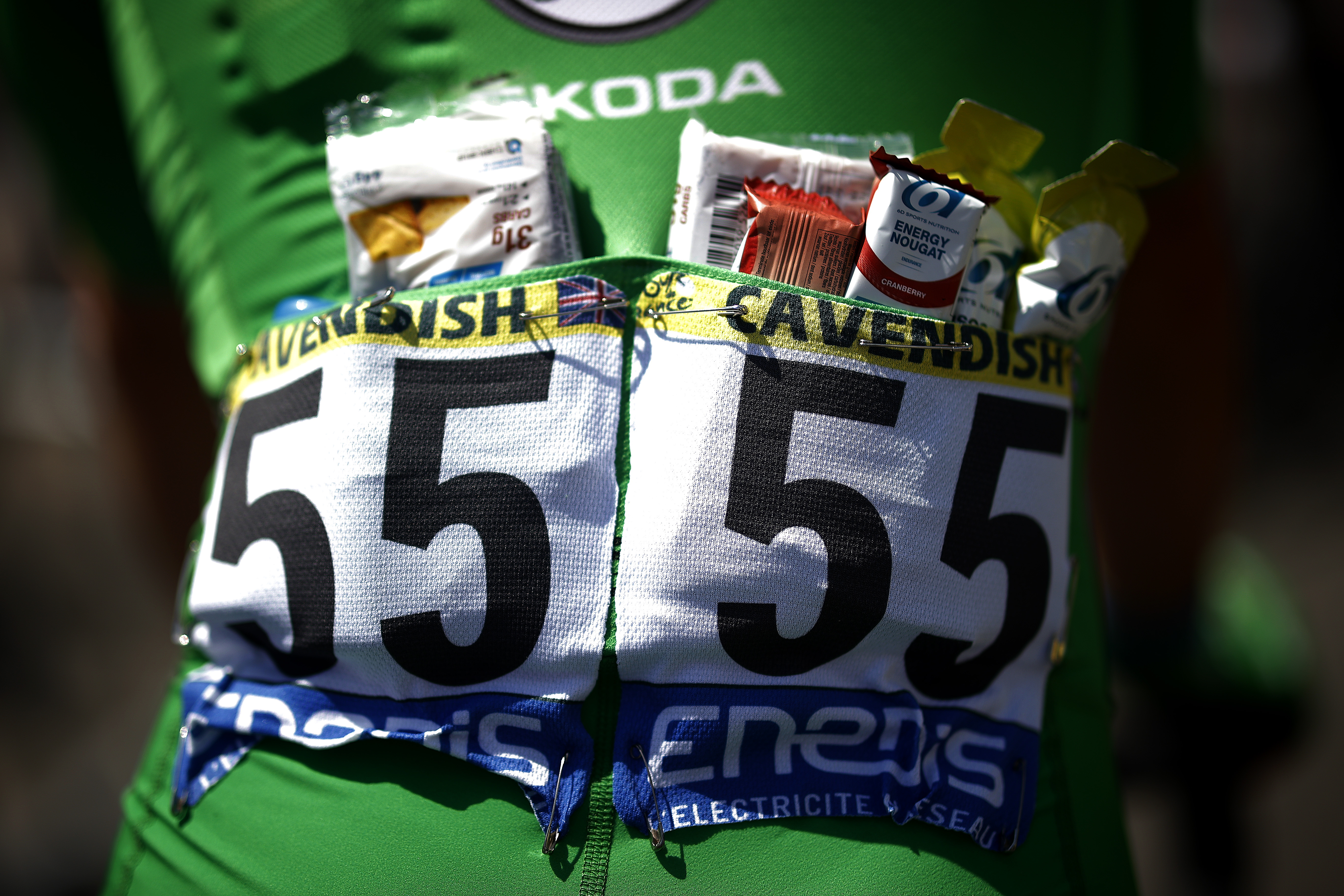
09:00: Breakfast
Riders will have breakfast around three and a half hours before the race, with carbohydrate-rich foods such as bread, muesli, cereal, pancakes, rice pudding, smoothies, orange juice - and even noodles - to help top up glycogen stores. An accompanying strong cup of coffee almost goes without saying.
The latest race content, interviews, features, reviews and expert buying guides, direct to your inbox!
Cycling is a team sport but there’s also individual needs during the race, with the riders playing different roles on each stage.
“We adapt the food to the needs, not just for the stage and also for the individual rider,” Trek-Segafredo’s nutritionist Stephanie Scheirlynck says. “And it’s not just day by day, it’s also about looking at the demands of the next block of stages.”
This means that the breakfast is adapted to the stage and the role that the rider has that day (or as part of an upcoming block).
“At breakfast we focus on the fuel for the stage that is coming,” Scheirlynck explains. “If it’s a mountain stage, we will go rich in carbohydrates because that’s your fuel for climbing, but we also make sure the food is low in fibre because you don’t want the food to cause any fluid retention.”
“Then, if it’s a flat stage, only the riders who are going for the breakaway will have more carbs and low fibre at breakfast.
“For the sprinter, who needs to stay in the peloton the whole day and only in the last 200 metres goes all out, energy expenditure is not comparable to a hilly stage or a mountain stage and this is reflected in the food they have at breakfast.”
In those three weeks, riders also need vegetables and fruit, fibre and healthy fats, and it’s on the easier stages that Trek-Segafredo gives the riders this healthier food. “I call them the green days and these are days when we know these sorts of foods are going to be digested,” Scheirlynck says.
10:30: Pre-race snack
Transfers from hotels to stage starts can be long, offering an opportunity to top up carbohydrates and calories in the team bus - typically, rice cakes with honey, raisin bread, sports bars or bananas are consumed with fluid.
Studies show Tour riders are consuming less on the bike (possibly due to more aggressive racing), meaning greater reliance on pre- and post-race nutrition.
12:00: During the race
Different stages at the Tour require different fuelling strategies, according to duration, intensity and temperature, and also on your role for the stage.
Fat metabolism can be utilised during mid-stage low intensity periods when a rider can shelter in the bunch and get towed along. In contrast, tougher stages will see the body rely on carbohydrates, which means more gels and energy drinks.
Solid foods consumed on the bike include small rolls with jam, rice cakes and energy bars, and most riders will opt for this on the easier days.
Quick-to-consume gels - especially caffeinated ones - will provide the majority of calories as the pace increases as riders will struggle to chew and swallow solids. Trek Segafredo also ups the concentration of its energy drinks for these tougher stages.
Fuelling on the bike also depends on personal preferences and what the rider is used to.
Scheirlynck gives Jasper Stuyven and Giulio Ciccone as examples of riders within Trek-Segafredo who fuel very differently.
“Stuvyn likes it simple, with everything in his bottle and he only takes on extra gels,” Scheirlynck says. “He trains at altitude training camps like that and so we know we can give him lots of fluid food and he’ll still be okay after seven hours.”
Then, other riders prefer to eat something solid. “Guillo Ciccone never wants his drinks to be overdosed because he prefers to eat something with it,” Scheirlynck shares. “Even if it’s a mountain stage, he wants solid food.”
17:00: Post-race recovery
As soon as the stage ends, recovery begins. “Recovery drinks with 0.3 to 0.4 grams of protein per kilogram of body weight, up to a maximum of 40 grams, are given to riders as soon as they finish a stage,” says Scheirlynck.
“We give this to riders in a shake because it’s easy to drink and it helps with rehydration too.”
They’re also freshly made. “We have a blender so we put in some fresh fruit, and some ice cubes too if it’s hot,” Scheirlynck adds.
Trek-Segafredo gives all its riders the same quantity for their recovery shake to drink while they’re cooling down, it’s the size of the recovery snack that riders also have that varies.
Depending on how long the transfer is (which could be up to a few hours), riders shower and change in the bus before eating a snack or small meal prepared by the team chef — pasta salad, a wrap or sandwiches, something with cooked rice are all standard. “It’s around half of what we give them at dinner,” Scheirlynck says.
20:00 or later: Evening meal
“Dinner depends on the next day, not the day they have just had,” Scheirlynck says.
Post-massage evening meals start with salad, soup or juice for a nutrient boost, followed by meat or fish and carbohydrate-rich foods — but gone are the days of overcooked pasta.
With long transfers this evening meal can end up being even later than 8pm.
“The good thing is that the riders are used to eating late because it’s also the case for other races,” Scheirlynck notes.“It seems as though they can digest everything a little bit faster than we would be able to.
Eating so late could reduce sleep quality though, which is not what you want during a Grand Tour. "If the riders are arriving at the hotel so late, then the team will give more to the riders in the bus so they can have a slightly lighter dinner," Scheirlynck adds.
The calories
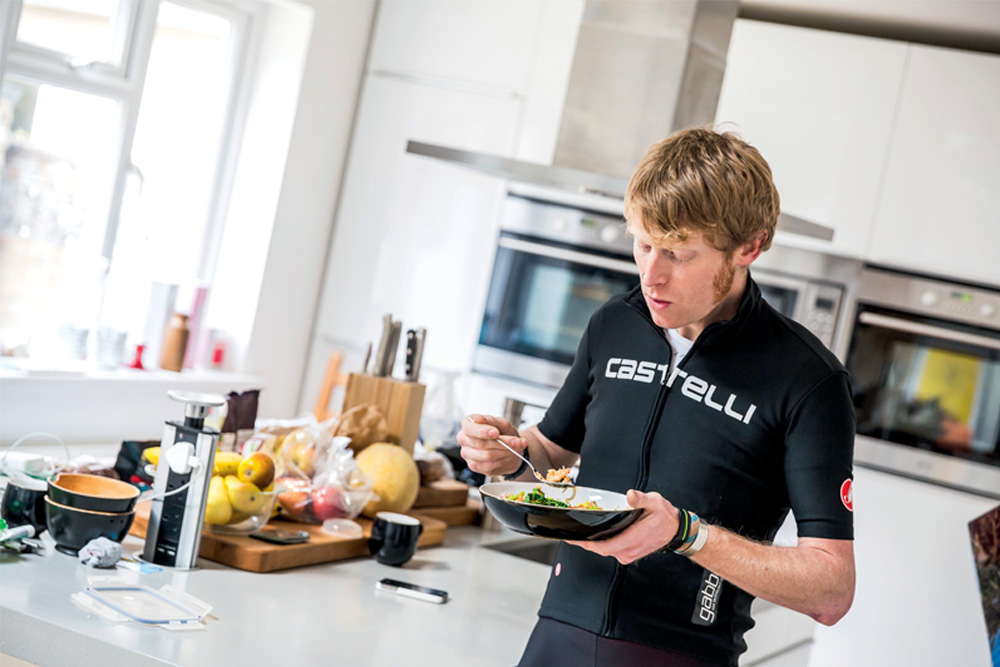
The most important nutritional consideration for riders is getting enough calories to meet the extreme demands of the race. This can be anything from 4,000 calories a day on a flat stage to 9,000 calories on a hilly stage.
Guzzling around 6,000 calories a day might sound blissful, but the reality of consuming such huge quantities of food day in, day out for three weeks presents one of the biggest challenges for the riders.
“Nutrient-dense foods are needed to remove the bulk of large volumes of food, to make it easier for riders to maintain energy balance and get enough nutrients,” says Mäder.
So bulky salads and vegetables are swapped for fresh fruit and vegetable juices, and carbohydrate powders are stirred into food and drink to increase calories.
The amount of food needed is close to the body’s maximum capacity for digestion, so failure to keep up with the enormous calorie intake can spell disaster, because playing catch-up is near impossible. And ending up in calorie deficit is a no-no because riders risk losing precious muscle.
The carbs
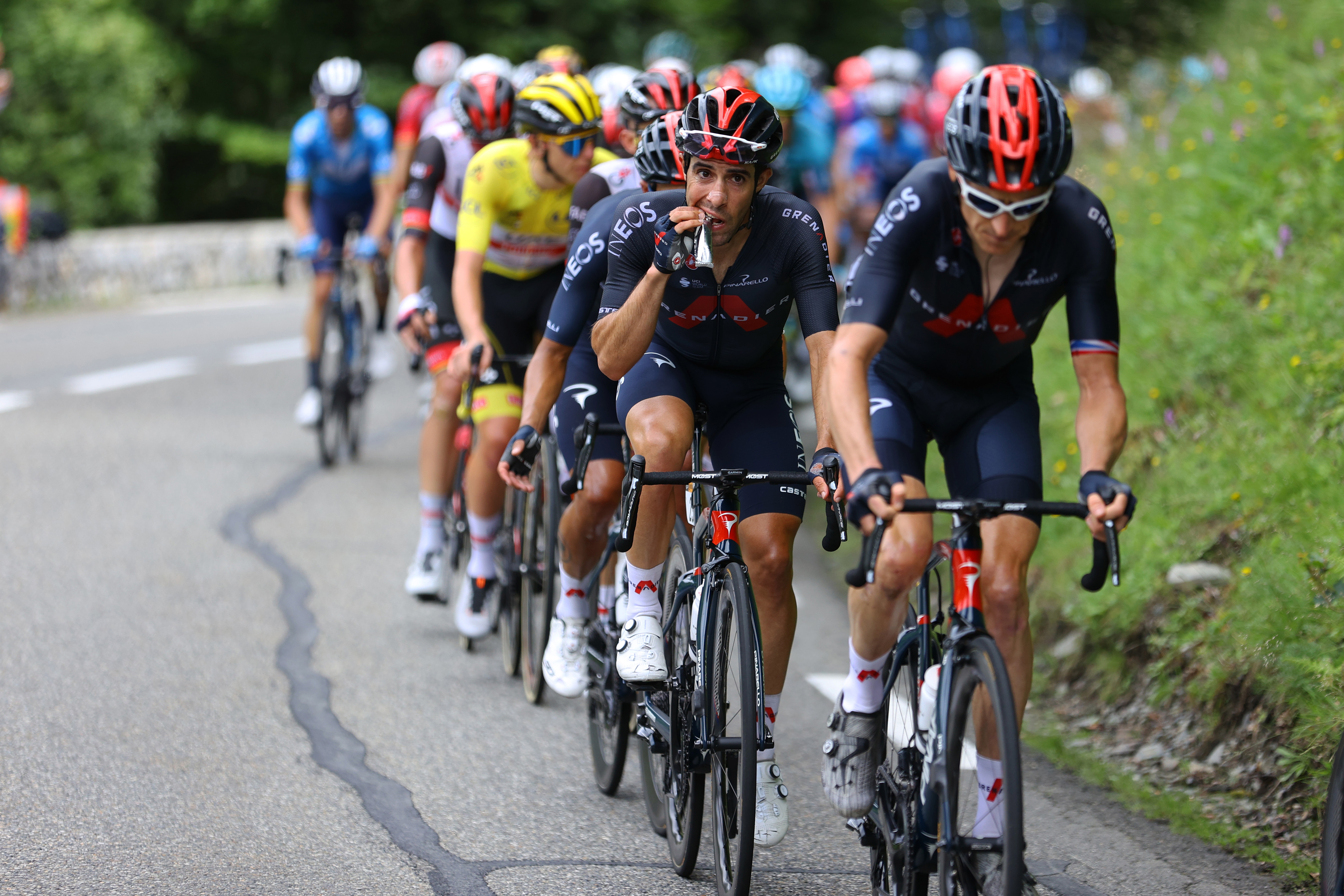
Carbohydrate consumption must begin as soon as the stage does.
As the body relies on glucose for energy during hard exercise, a high proportion of the calories consumed by riders come from carbohydrate — around 70 per cent, or 1,100g a day for a 70kg rider, according to Emma Barraclough, senior sports nutritionist at SiS.
“Carbohydrate is needed for high-intensity efforts, such as breakaways and tough climbs,” explains Barraclough.
Swallowed in energy bars, gels and energy drinks, riders consume around 250 calories or 60g of carbohydrate per hour. “Riders take in energy little and often — 36g of carbohydrate from their drink every hour with a gel or bar every 30 minutes as well,” says Barraclough.
During the longest stages, carbohydrate intake can jump to 80 or 90g per hour — but the key is to start early. “If riders don’t fuel and drink properly, they will not be in contention when it comes to the critical part and finale of a stage,” says Pete Slater, co-founder of OTE Sports.
“Riders start taking drink, food and gels on board as soon as they get going.”
Food logistics
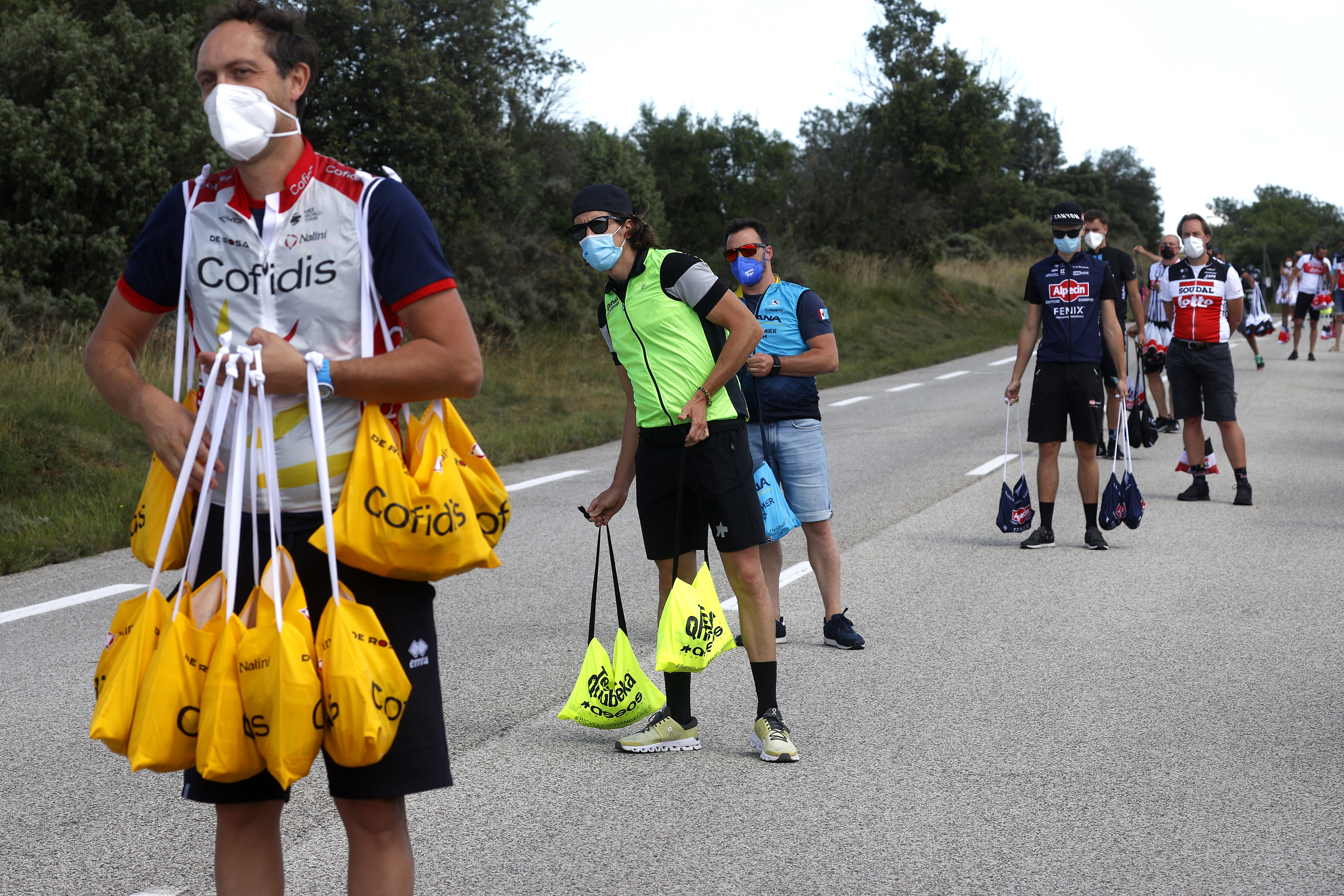
Race food must be easy to eat, but variety is necessary too.
Food consumed during the race needs to be portable and easy to consume on the bike. Riders start with food and gels in their jerseys, picking up additional supplies from musettes around halfway through the stage, packed by soigneurs at the start of each day.
Teams will label bottles so riders know what’s inside and can calculate what they need based on their role within the team for the day’s stage.
“In the musettes we put everything so the riders can choose what they like themselves,” Scheirlynck explains. “You can’t have bottles or musettes with names on because you never know who is going to come first.”
A typical musette bag may contain two 500ml bottles, one of water and one sports drink for hydration and fuel, an energy bar to eat when the pace is less intense, and isotonic gels with caffeine for that extra lift when needed.
There’s homemade rice cakes or fruit cakes to prevent hunger, and help with variety on long stages. This solid food is all low in fibre and rich in carbs.
There’s also always one small can of coke in the musettes Trek-Segafredo gives its riders. “From a nutritional point of view, it doesn’t make any sense to put a coke in there, but if taking a few sips helps the riders morale then that effect is more important than the disadvantage that doesn’t exist,” Scheirlynck explains, “and that’s why we leave it in there.”
Bars and sandwiches are kept for the flat stages, with gels and drinks used on climbs as it’s more difficult to take on food then. Bottles with a sports drink and three gels taped on are picked up from team cars, with sandwiches and gels available from support teams on the side of the road.
Food consumed off the bike is just as important. Most teams travel with their own nutritionist and chef, a practice that has helped improve the quality of food and prevents one of the biggest blights of the high calorie regime — food fatigue. The chef and nutritionist work together to plan menus, taking into account rider preferences, with some requiring gluten or lactose-free meals.
Providing food that the riders like helps ensure that they eat enough for the efforts they have coming up and this is why the teams put effort into making functional food into a package that looks good, such as pizza.
“Food is also more than just functional,” Scheirlynck notes. “It gives you the energy to do the race but if you’ve had a bad day, or you crashed, it can make you feel better.”
Hydration
Avoiding dehydration in hot weather is another challenge — sweat losses can be in excess of three litres during hard stages, and riders may need to consume up to 10 litres a day to maintain fluid balance.
Fluid is lost through sweat and breath, and losses are exacerbated in hot weather. But it’s not just fluid — electrolytes such as sodium and potassium also need to be replaced to avoid the risk of hyponatremia, or low sodium levels, a potentially fatal condition that can be caused by overdrinking plain water.
“The sodium content in an electrolyte drink is crucial in helping the riders keep fluid balance in their body. Up to a litre an hour can be lost in the heat at altitude in the mountains,” explains Barraclough.
“Pre-hydrating starts in the morning by putting extra electrolytes in the rider's drinks,” Scheirlynck says. Taking on fluids then becomes an all-day task whether the riders are on their bikes or not.
On particularly hot days, Trek-Segafredo also freezes the gels to help riders cool from the inside.
Recovery
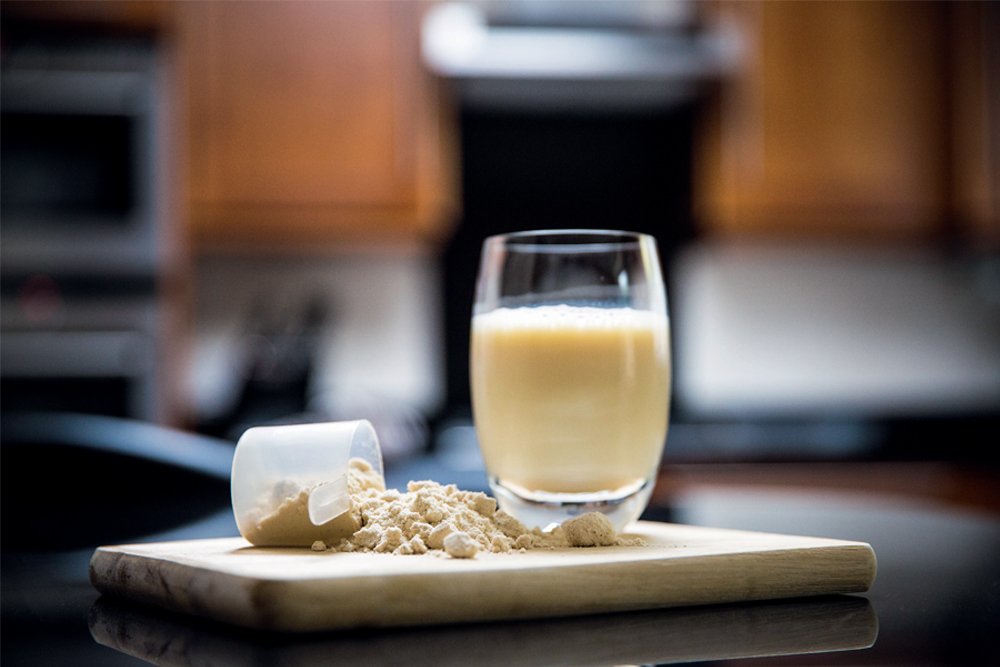
After each stage recovery takes precedence, with the priority on replenishing glycogen stores and helping muscles recover as quickly as possible.
Most teams drum into their riders the importance of the nutritional 20-minute ‘golden window’, which starts as soon as exercise stops.
Recovery involves three parts: carbohydrate, protein and fluid. A cyclist’s body needs carbohydrates to replenish depleted glycogen stores, high-quality protein for repairing the damaged muscle tissue and fluid plus electrolytes for effective rehydration.
A recovery drink is ready to go so riders can consume while cooling down.
As training techniques and bike design advance, so do the nutritional products that support the riders. “Research findings are translated into practical application — not just the ingredients but also factors such as mouth feel, taste, packaging and application — for example, how easy a product is to open and consume during a ride,” says Mäder.
Many transportable carb-based products contain multiple forms of sugars (glucose plus fructose) which help riders absorb and use more carbohydrate per hour than conventional nutrition products, maximising delivery to the working muscles.
Multi-day racing batters immune function, but probiotics can bolster the body’s defences. “Probiotic drinks are also used to aid immune function, as the rider’s body will naturally be under a lot of stress,” explains Slater.
While the team nutritionist helps the riders judge how much carbohydrate and protein they should take to recover and fuel for the next day, Scheirlynck notes that some things aren’t easy to calculate and that the riders have control here.
“If you’ve crashed you need more energy to recover and we can’t really estimate how much, but if the riders listen to their body they can at least take a bit more if they feel like they need a bit more.”
Caffiene
Caffeine is one of the only legal performance-boosting aids available, and riders will often have a coffee with their breakfast or take a caffeine gel before the start of the race.
“It helps lower the perception of effort,” says Barraclough, “so it can be useful on a long hilly day.”
Riders will also take another caffeine gel during the race, around 30 to 45 minutes before they need it.
“The timing depends on your task,” Scheirlynck points out, “because sometimes you need to start working earlier than someone else.”
This is also why many riders start with a caffeine gel in their jersey pocket and keep one reserved for when it really matters.
“If you’re suddenly in a position where you didn’t expect to be, but you have the opportunity to win, you can be flexible,” says Scheirlynck.
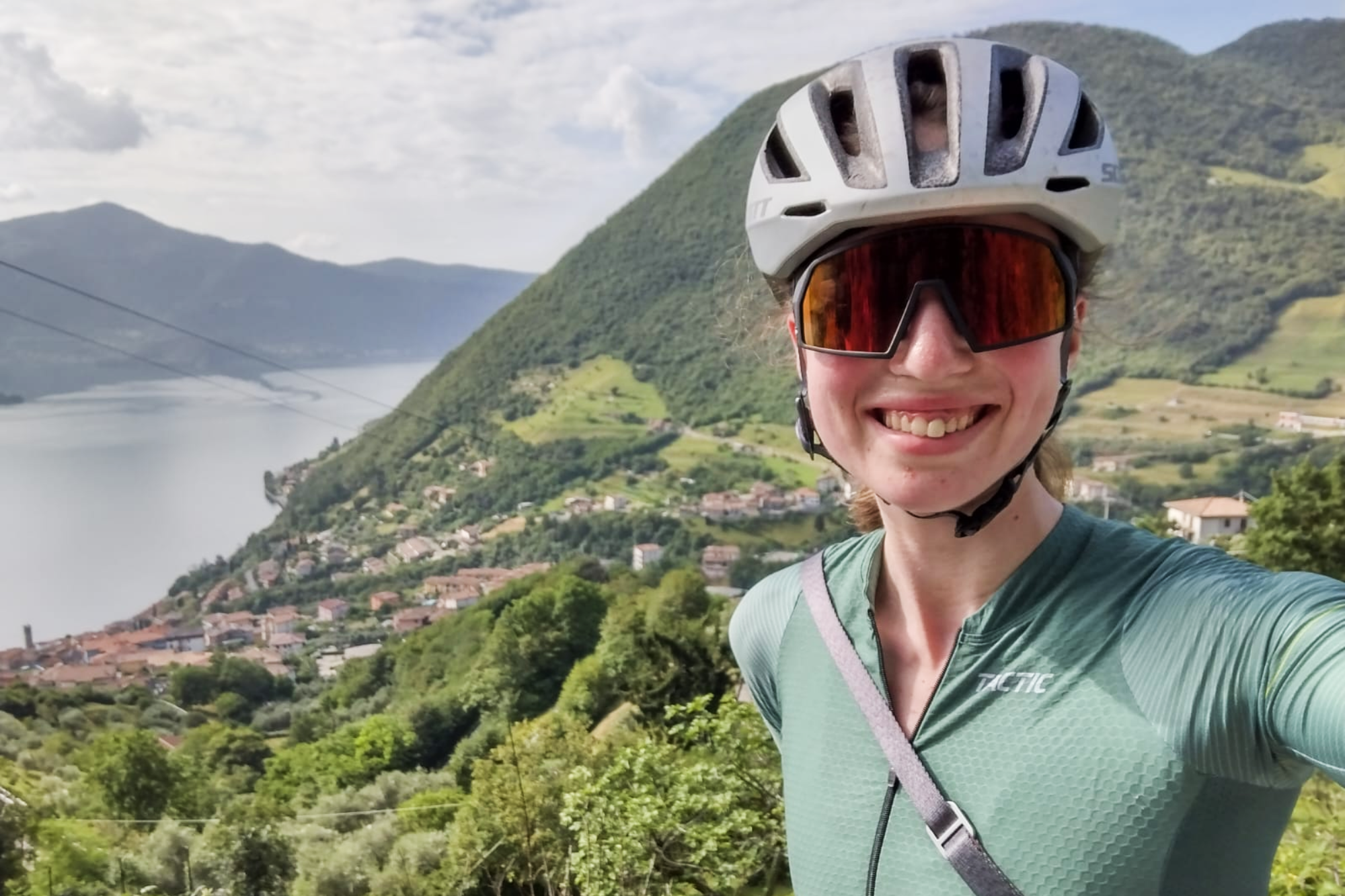
I’ve been hooked on bikes ever since the age of 12 and my first lap of the Hillingdon Cycle Circuit in the bright yellow kit of the Hillingdon Slipstreamers. For a time, my cycling life centred around racing road and track.
But that’s since broadened to include multiday two-wheeled, one-sleeping-bag adventures over whatever terrain I happen to meet - with a two-week bikepacking trip from Budapest into the mountains of Slovakia being just the latest.
I still enjoy lining up on a start line, though, racing the British Gravel Championships and finding myself on the podium at the enduro-style gravel event, Gritfest in 2022.
Height: 177cm
Weight: 60–63kg